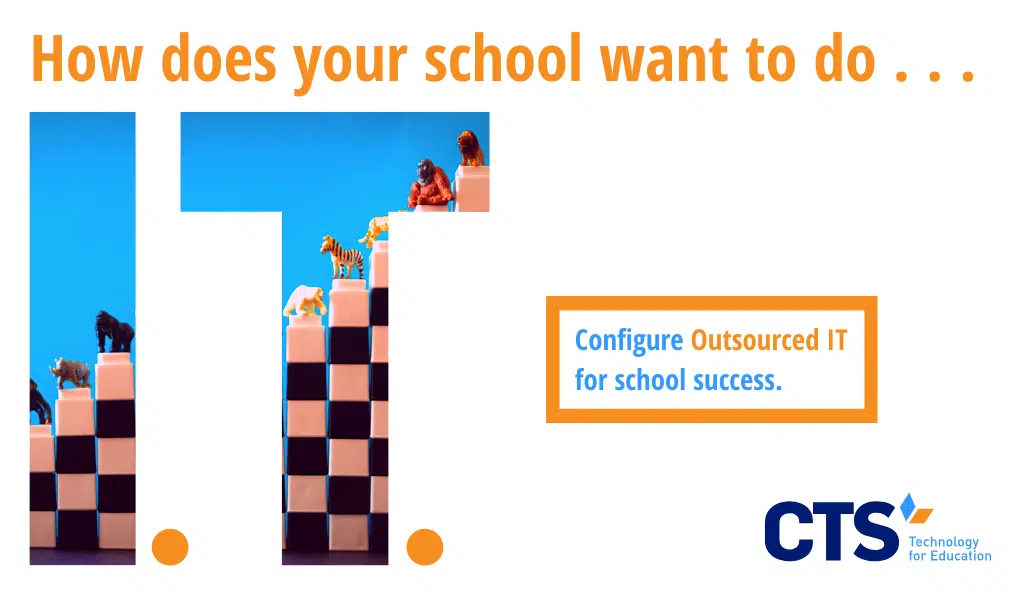Choosing the right IT service configuration significantly impacts other areas of school programming.
Walk into almost any school in the United States today, and you’ll quickly encounter at least one piece of instructional technology. From Chromebooks and staff laptops to projectors and SMART boards, a school’s IT offerings directly support instruction. Remote learning has only underscored these trends, further cementing the importance of instructional technology to the broader educational enterprise.
Defining the structure of an IT team and then selecting an effective IT service provider increasingly impacts both the delivery and ultimate quality of school programming. With that said, one team’s structure won’t necessarily translate to another school, which may have vastly different needs. Below, we summarize key differences between IT service delivery models, as well as the pros and cons of each approach.
Some schools may choose to keep IT services in-house, depending on overall capacity.
Many well-established schools choose to keep IT services in-house, meaning they directly employ the individuals responsible for the school’s technology programming. In addition to greater control over hiring and team structure, an in-house set-up often allows schools to take a more hands-on approach to their technology programming. Rather than negotiating what devices an external provider will or won’t service, for example, an in-house team is responsible for any and all school technology.
While sometimes viewed as more personalized, the in-house approach also demands greater resources, both in terms of time and money. School leaders may also find it difficult to find a single person responsible for both high-level IT strategy, as well as daily troubleshooting and ticketing management, forcing them to hire additional personnel to manage the entire IT workstream. Annual salaries for multiple employees quickly add up, often eclipsing the annual cost of an external provider who, while not as deeply entrenched in daily school operations, can more ably provide a comprehensive scope of IT services at a reasonable cost.
In-house IT teams must often look elsewhere for more specific technical support.
In addition to cost, in-house IT teams may lack the expertise to solve every technology problem at a school. An individual who excels at device management and inventory, for example, may not understand the intricacies of the federal E-rate process or the design specs of a particular wireless cabling set-up. These gaps in knowledge can ultimately impact the school’s budget, forcing leadership to bring in external providers for larger or more complex projects. This isn’t necessarily a bad thing, but scenarios like these undercut arguments that hiring an in-house team is always more affordable than bringing in an external provider.
In-house IT teams may lack the time and resources to keep the school current on the latest technology trends.
Similarly, keeping your school up to date on the latest technology trends and products requires significant time and attention. An in-house IT team is already incredibly busy. From inventorying Chromebooks and responding to individual teacher and staff tickets, to attending school-wide operations meetings, tasks that don’t relate to day-to-day school can quickly fall by the wayside. Here, too, external consultants may be able to meet some of the needs, but these resources will, of course, impact the school’s financial resources.
Completely outsourced IT service models can save school administrators significant time.
For these reasons, both start-up and well-established schools often choose to outsource their IT services to a third party. Among the many potential benefits of this approach, administrators can be a bit more hands-off in their approach, which in turn allows them to spend time on other educational priorities. Rather than running IT team meetings or establishing weekly priorities for individual IT team members, school operations leads can work on an as-needed basis with IT personnel and direct teachers and other staff members to email, phone, or other ticketing systems when they need support.
Outsourced IT teams typically feature a broad division between technical and non-technical staff.
Within outsourced IT service providers, staffing models typically feature a broad divide between technical and non-technical staff or project managers. In the former category, schools can expect to engage technicians and engineers who often come on-site to solve specific technical issues at the school, like replacing WAPs, setting-up Chromebook carts, or troubleshooting problems with individual devices that can’t be solved remotely.
Project managers, on the other hand, are often the main point of contact for school operations leads, fielding questions about long-term technology programming efforts and translating the school’s needs to technical team members. From summer work planning to new school launch or expansion, project managers help schools drive their long-term technology priorities.
Outsourced IT teams typically have more capacity to support long-term planning efforts.
Due to their relatively greater capacity, outsourced IT service providers are typically better able to support long-term planning efforts than smaller, in-house teams. In addition to more robust staffing capacity, these companies also have greater exposure to the educational technology marketplace, both through their work with other schools and their relationships with educational technology vendors.
This knowledge is particularly useful for schools looking to expand enrollment or add another site, daunting tasks that could quickly overwhelm an in-house IT service team. When needed, third-party providers may also be able to provide additional staffing that goes beyond their normal scope of work.
At CTS, we work with each client to create an IT service program that supports their unique mission.
At CTS, we’ve served more than 20,000 students in more than 60 schools across the United States. No matter their IT service set-up, we’ve worked with our partners to craft IT service models that help schools accomplish their unique missions. Contact us today to learn more about our managed IT services, as well as our supplemental IT staffing opportunities.




